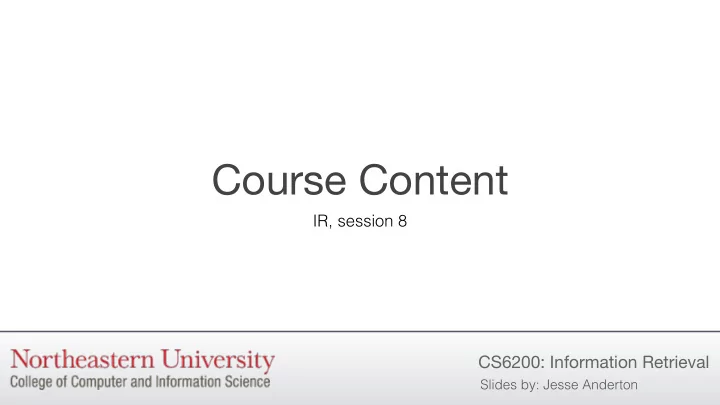

Course Content IR, session 8 CS6200: Information Retrieval Slides by: Jesse Anderton
Big Questions in IR Here are some questions we’ll discuss: • What’s the most effective way to perform semantic matching? • What else can improve a ranking, besides semantic matching? • How can we identify and remove malicious web content (e.g. spam)? • How can we make search more efficient, so queries require fewer resources? • How do we move beyond keyword search?
Module 2: Vector Space Models The next module covers Vector Space Models in more depth. It addresses three big questions: ‣ How do we pick the best terms to represent the query? ‣ What term score function should we use to improve on TF? ‣ What matching score function should we use instead of the dot product?
Module 3: Language Models This module does probabilistic semantic matching using NLP-style language models. It addresses: ‣ How to build a probabilistic model of word usage ‣ How to use these models to estimate the likelihood that the query and document are on the same subject ‣ How to “fix” your model when you don’t have enough data to train it (e.g. for short documents, or queries)
Module 4: Combining Evidence Here we discuss improving a ranking by adding extra information to the semantic matching scores: ‣ Estimating the overall quality of a document ‣ Identifying document types using Machine Learning ‣ Mixing together many sources of relevance information to produce a final ranking
Module 5: Document Understanding This module discusses ways to get a stronger signal of the document’s topic: ‣ Finding text emphasized by the document’s structure ‣ Finding named entities (proper nouns) mentioned in the document ‣ Mathematical models of document topics ‣ Clustering similar documents together
Module 6: Crawling Here we move to the mechanics of search, and discuss how to find documents on the Internet: ‣ Selecting the right documents to crawl (because you can’t crawl everything) ‣ Deciding when to re-crawl documents you’ve already crawled ‣ Avoiding some of the common pitfalls of crawling the web
Module 7: Indexing This module discusses the inverted index in depth: ‣ Creating an inverted index from raw documents ‣ Storing term, document, and corpus level content in your index ‣ Efficiently reading the index at search time
Module 8: Interfaces and Logs Here, we cover ways to improve the user interface and use recorded user interaction to improve search quality: ‣ Giving users more information about documents, so they can decide what to click on ‣ Using click data to decide whether documents are relevant ‣ Generating user profiles, and using them to customize search ‣ Performing location-specific queries
Module 9: Evaluation How can you tell whether your search engine is good, whether it’s improving, and whether it can get better? ‣ Mathematical models of user interaction to compare rankings ‣ Measuring actual user interaction to compare rankings ‣ Choosing the best evaluation approach for your specific task
Module 10: Beyond Keywords We explore interesting query types that move beyond keyword search: ‣ Answering questions posed in natural language ‣ Generating summaries of the available information in the collection ‣ Building a knowledge graph from information on the Internet, and performing logical inference on its contents
Module 11: Beyond Text This module discusses searching for non-textual content: ‣ Searching for images, video, and music ‣ Finding other objects “like this one” ‣ Product recommendation based on user ratings
Module 12: Adversarial IR Many users on the web seek to exploit IR systems to make money at the expense of search quality. This module covers: ‣ The tricks of the trade for malicious web users ‣ Various ways to identify spam on the web ‣ Detecting and responding to link farms
Module 13: Advertising Search engines are expensive. How can we make money with them without sacrificing search quality? This module covers: ‣ Selecting relevant ads for web $$$ queries ‣ Placing appropriate ads on web pages ‣ Preserving a good user experience by managing ad quality
Module 14: Learning to Rank This module discusses modern approaches of Machine Learning to IR ranking: ‣ How to cast ranking as a Machine Learning problem ‣ Various major approaches taken by Learning to Rank algorithms ‣ Features used by LtR
Module 15: Semantic Matching Our final module covers advanced and experimental approaches to semantic matching: ‣ A deeper discussion of the semantic matching problem ‣ Projecting documents and queries into a latent space ‣ Casting semantic matching as a Machine Learning problem (with applications far beyond ranking!)
Wrapping Up • That’s it!
Recommend
More recommend